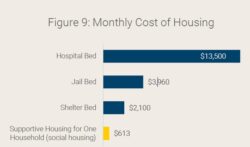Post #253
570 words; 3 minutes to read
La version française suit par la bénévole Rachel Cauver
Summary: Being jailed increases the chances of being homeless, and makes it harder to escape that situation.
Audio summary by volunteer Kimberly Duong.
The huge problems around homelessness in Canada are well known. Less well known is the strong connection between jailing people and them becoming homeless. Even short periods in jail greatly increase the chances of a person’s becoming, and remaining, homeless.
A recent report from the John Howard Society of Ontario and its partners, Locked up and Locked Out, illustrates in detail how this connection works. This study surveyed and interviewed more than 150 people who had dealt with the criminal justice system and with homelessness, and shows the many ways in which the two are intertwined. It focuses on Ontario provincial jails, where most people (over 70%) are held on remand, and where sentences tend to be short, typically 30 days or less.
The group involved in the study was very diverse – men and women, of varying ages and ethnicities. Many had other issues such as mental health or substance abuse problems – which we know are prevalent in the jail system.
Incarceration represented an economic disaster for many individuals.
Within that overall conclusion, the study had five major findings.
- Involvement with the justice system is a leading cause of housing loss, even if that involvement does not lead to incarceration. 40% of the group said their most recent loss of housing was a result of arrest or imprisonment. An similar number said that they had faced discrimination in finding housing, often due to having a criminal record. Having a criminal record is itself a major barrier to finding housing.
- Incarceration causes and perpetuates housing loss. About half of those who had housing prior to their most recent involvement with the justice system lost that housing as a result. Other studies have found similar results – for example in Nova Scotia.
- Pre-release services in provincial jails are inadequate. As a result, people released from a correctional facility were often released into shelters or transitional homes, stayed with family or friends, or had nowhere to go upon release and were thus released to live on the streets. Once homeless, many were at increased risk of contact with the police and re-incarceration.
- Community services post-release are also inadequate, often involving long wait times, strict eligibility requirements, or travel to distant parts of the city. Even access to a phone was often a challenge for newly-released people. As a result, people, often in very difficult situations, cannot get the help they need.
- There are significant gaps in services. Things that people most need, such as some financial assistance or mental health supports, are just not available. Just as people who are arrested may lose their housing they may lose their employment as well so have no means to pay for housing, and without housing cannot find employment.
The poor organization and level of support in this area imposes high costs not just on the people involved, but on the public. As the figure shows, providing supportive housing is vastly cheaper even than a bed in a shelter, let alone the cost of keeping someone in jail.
The problem of housing is, of course, connected to many other social issues, such as the inadequate level of social assistance payments, inadequate wages especially for those in marginal work, and the general problem of affordable housing in Canadian cities. All of these are linked to crime and also make things harder for those trying to rebuild their lives after involvement with the criminal justice system.
About this blog: The John Howard Canada blog is intended to support greater public understanding of criminal justice issues. Blog content does not necessarily represent the views of John Howard Canada. All blog material may be reproduced freely for any non-profit purpose as long as the source is acknowledged. We welcome comments (moderated).
En francais
L’article met en lumière la relation complexe entre l’incarcération et l’itinérance au Canada, en se concentrant particulièrement sur les prisons provinciales de l’Ontario. À partir d’entretiens réalisés avec plus de 150 personnes ayant vécu l’expérience du système de justice pénale et de l’itinérance, l’étude révèle que l’incarcération est fréquemment un catalyseur ou un facteur aggravant de l’instabilité résidentielle. Près de 40 % des participants ont déclaré avoir perdu leur logement à la suite d’une arrestation ou une incarcération, y compris ceux disposant d’une stabilité résidentielle auparavant.
L’étude met également en évidence des défaillances systémiques, notamment le manque de services de soutien adéquats avant et après la réinsertion. De nombreuses personnes sont orientées vers des refuges, des logements de transition ou se retrouvent directement dans la rue, sans accès à des ressources essentielles comme les moyens de communication, l’aide financière ou les services de santé mentale. Ces lacunes sont exacerbées par des délais d’attente prolongés et des critères d’éligibilité stricts pour les programmes communautaires, compliquant ainsi les efforts de réintégration et perpétuant les cycles d’itinérance et de réincarcération.
Ces insuffisances sont amplifiées par des problèmes sociaux plus larges, tels que des niveaux d’assistance sociale insuffisants, des emplois précaires et la crise du logement abordable au Canada. Combinés, ces facteurs renforcent les obstacles à la réinsertion et soulignent l’urgence de réformes systémiques pour résoudre les liens entre l’itinérance et le système de justice pénale
Back


Comments are closed here.